分子别名(Synonym)
PDCD1,PD1,CD279,SLEB2
表达区间及表达系统(Source)
Human PD-1 Protein, Fc Tag (PD1-H5257) is expressed from human 293 cells (HEK293). It contains AA Leu 25 - Gln 167 (Accession # NP_005009.2).
Predicted N-terminus: Leu 25
Request for sequence
蛋白结构(Molecular Characterization)

This protein carries a human IgG1 Fc tag at the C-terminus.
The protein has a calculated MW of 42.1 kDa. The protein migrates as 56-66 kDa under reducing (R) condition (SDS-PAGE) due to glycosylation.
内毒素(Endotoxin)
Less than 0.1 EU per μg by the LAL method.
纯度(Purity)
>95% as determined by SDS-PAGE.
>90% as determined by SEC-MALS.
制剂(Formulation)
Lyophilized from 0.22 μm filtered solution in PBS, pH7.4 with trehalose as protectant.
Contact us for customized product form or formulation.
重构方法(Reconstitution)
Please see Certificate of Analysis for specific instructions.
For best performance, we strongly recommend you to follow the reconstitution protocol provided in the CoA.
存储(Storage)
For long term storage, the product should be stored at lyophilized state at -20°C or lower.
Please avoid repeated freeze-thaw cycles.
This product is stable after storage at:
- -20°C to -70°C for 24 months in lyophilized state;
- -70°C for 24 months under sterile conditions after reconstitution.
质量管理控制体系(QMS)
电泳(SDS-PAGE)
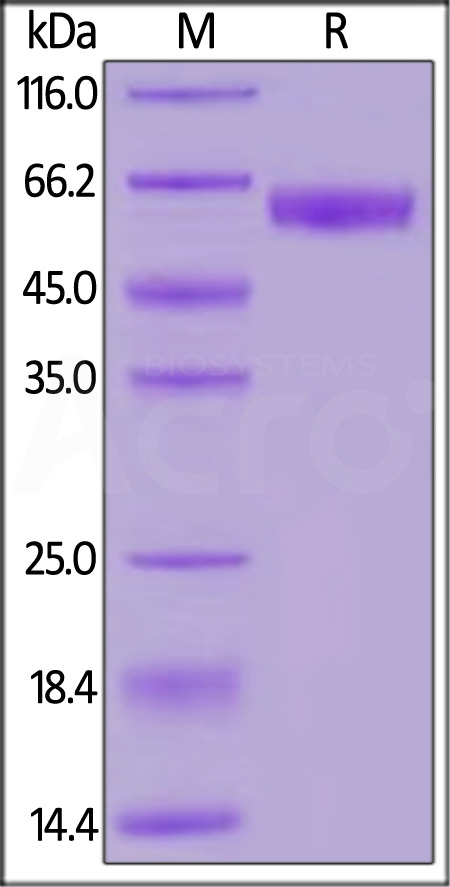
Human PD-1 Protein, Fc Tag on SDS-PAGE under reducing (R) condition. The gel was stained with Coomassie Blue. The purity of the protein is greater than 95%.
SEC-MALS
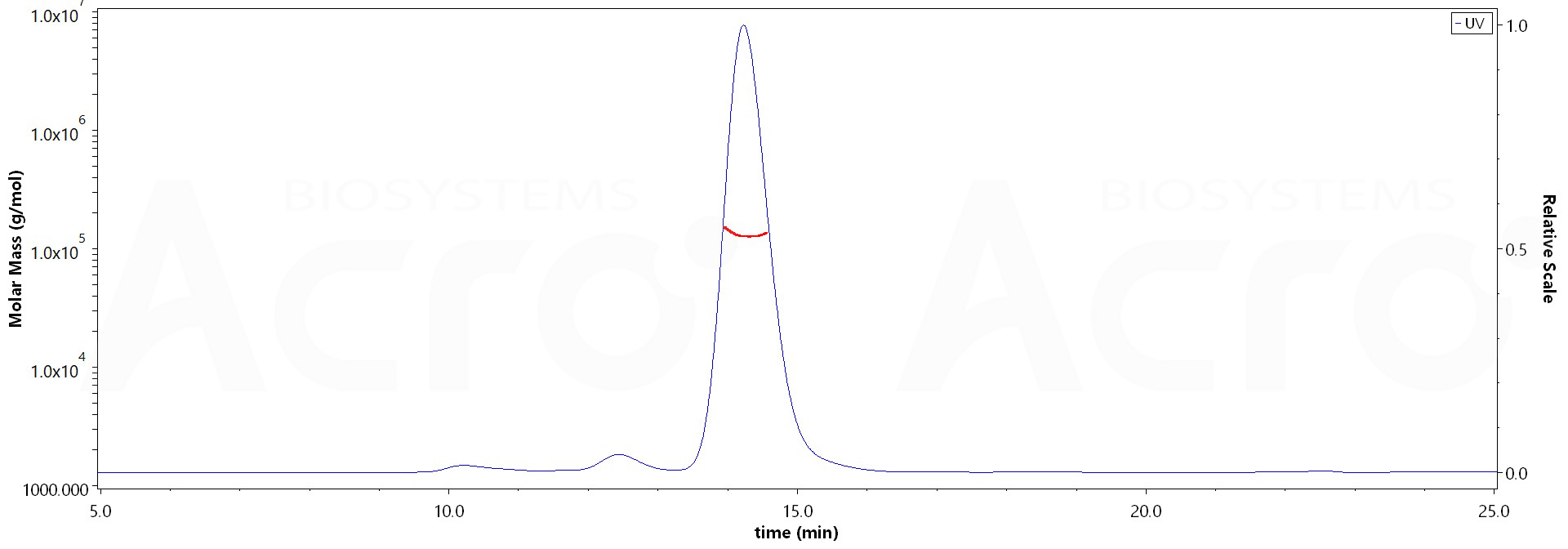
The purity of Human PD-1 Protein, Fc Tag (Cat. No. PD1-H5257) is more than 90% and the molecular weight of this protein is around 105-145 kDa verified by SEC-MALS.
Report
活性(Bioactivity)-ELISA
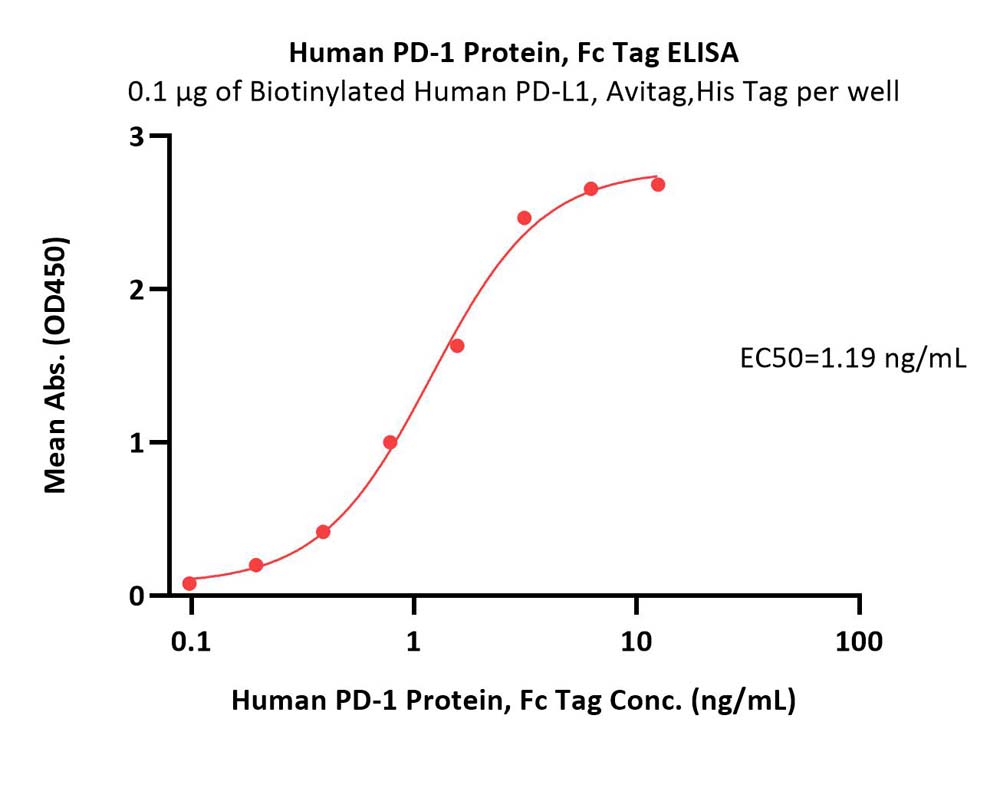
Immobilized Biotinylated Human PD-L1, Avitag,His Tag (Cat. No. PD1-H82E5) at 1 μg/mL (100 μL/well) on streptavidin precoated (0.5 μg/well) plate, can bind Human PD-1 Protein, Fc Tag (Cat. No. PD1-H5257) with a linear range of 0.1-3 ng/mL (QC tested).
Protocol
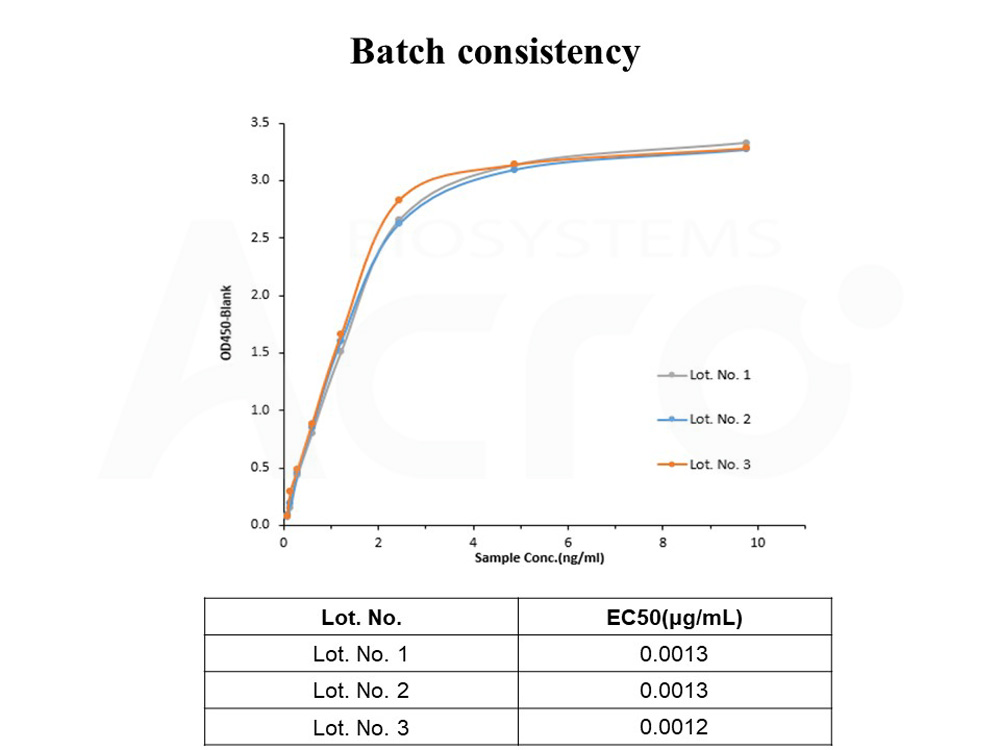
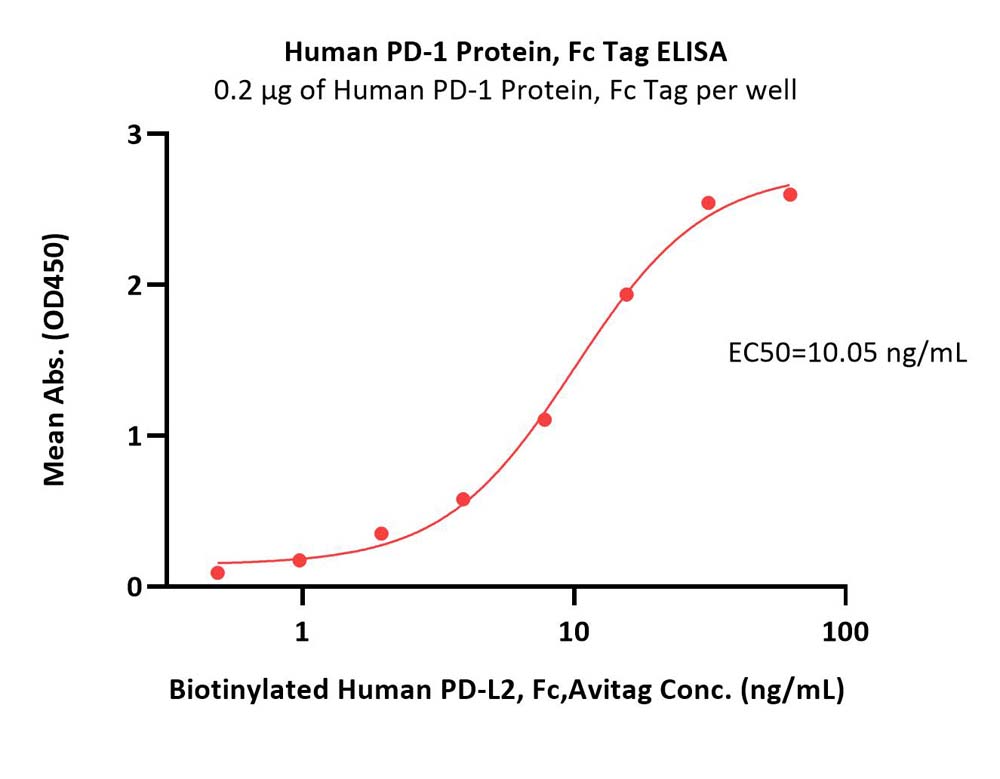
Immobilized Human PD-1 Protein, Fc Tag (Cat. No. PD1-H5257) at 2 μg/mL (100 μL/well) can bind Biotinylated Human PD-L2, Fc,Avitag (Cat. No. PD2-H82F6) with a linear range of 0.5-16 ng/mL (Routinely tested).
Protocol

Immobilized Biotinylated Human PD-L2, Avitag,His Tag (Cat. No. PD2-H82E8) at 1 μg/mL (100 μL/well) on streptavidin precoated (0.2 μg/well) plate, can bind Human PD-1 Protein, Fc Tag (Cat. No. PD1-H5257) with a linear range of 0.1-1 ng/mL (Routinely tested).
Protocol

Serial dilutions of nivolumab were added into Human PD-1 Protein, Fc Tag (Cat. No. PD1-H5257): Biotinylated Human PD-L1, Fc,Avitag,His Tag (Cat. No. PD1-H82F3) binding reactions. The half maximal inhibitory concentration (IC50) is 0.5381 μg/mL (Routinely tested).
Protocol
活性(Bioactivity)-SPR

Human PD-1 Protein, Fc Tag (Cat. No. PD1-H5257) captured on CM5 chip via anti-human IgG Fc antibody, can bind Human PD-L1, His Tag (Cat. No. PD1-H5229) with an affinity constant of 3.6 μM as determined in a SPR assay (Biacore T200) (Routinely tested).
Protocol
活性(Bioactivity)-BLI
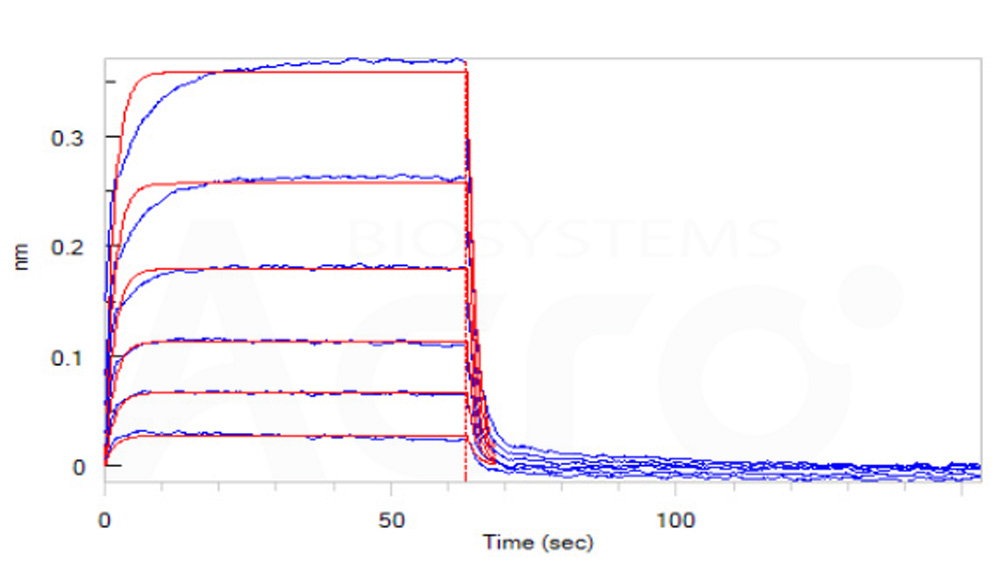
Loaded Human PD-1 Protein, Fc Tag (Cat. No. PD1-H5257) on ProteinA Biosensor, can bind Human PD-L1, His Tag (Cat. No. PD1-H5229) with an affinity constant of 5.3 μM as determined in BLI assay (ForteBio Octet Red96e) (Routinely tested).
Protocol
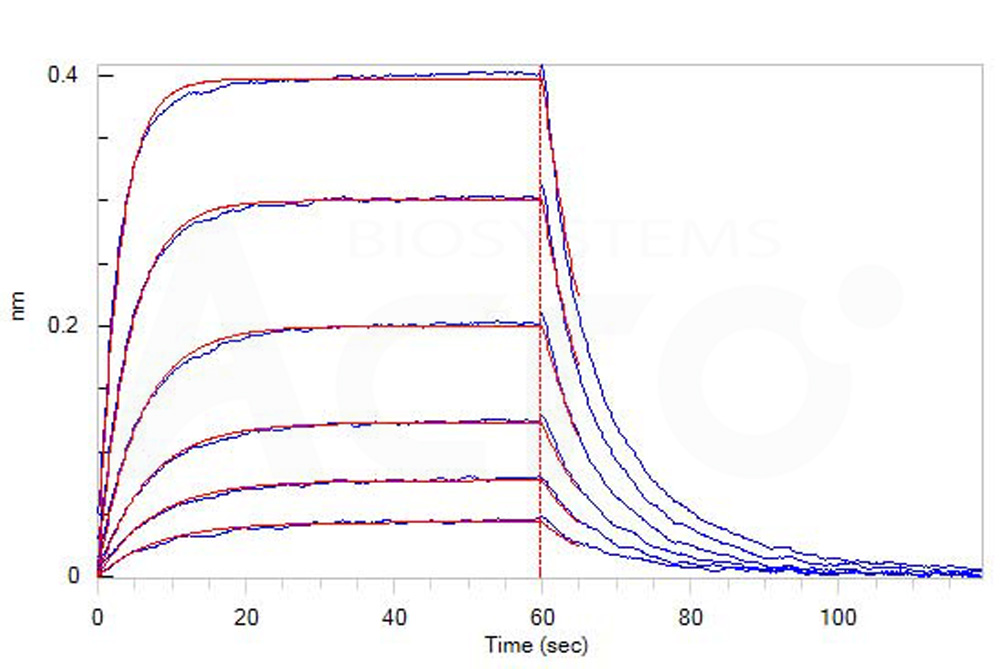
Loaded Human PD-1 Protein, Fc Tag (Cat. No. PD1-H5257) on Protein A Biosensor, can bind Human PD-L2 Protein, His Tag (Cat. No. PD2-H5220) with an affinity constant of 0.45 μM as determined in BLI assay (ForteBio Octet Red96e) (Routinely tested).
Protocol
活性(Bioactivity)-FACS

Flow Cytometry assay shows that Human PD-1 Protein, Fc Tag (Cat. No. PD1-H5257) can bind to 293 cell overexpressing human PD-L1. The concentration of PD-1 used is 1 μg/mL (Routinely tested).
Protocol
 +添加评论
+添加评论
- 130XXXXXXX2
- 这一款PD-蛋白应用于多个抗体药项目中均具有非常好的稳定性,与单抗分子与PD-L1, PD-L2都有稳定的结合能力,不同批次间重现性稳定,目前已经回购过多次,附赠的COA及实验protocol在我们实验室可以非常好的重复,对项目开展有指导意义!
 >
>- 2022-2-28

- 177XXXXXXX0
- 物流快。这个抗原买来做产品检测的,所以选择了结合性好的,实验效果还不错,正常情况下,稳定性和工艺样品检测需要用到很多抗原,如果抗原结合不稳定会导致实验结果重复性不好,用这个抗原后基本上都可以满足系统适应性了,这样算下来,实验次数减少了,抗原用量也就少了,综合看来还是相对便宜一点。另外还送了试用装,非常nice,还会继续购买的。
- 2020-7-23
背景(Background)
Programmed cell death protein 1 (PD-1) is also known as CD279 and PDCD1, is a type I membrane protein and is a member of the extended CD28/CTLA-4 family of T cell regulators. PDCD1 is expressed on the surface of activated T cells, B cells, macrophages, myeloid cells and a subset of thymocytes. PD-1 has two ligands, PD-L1 and PD-L2, which are members of the B7 family. PD-L1 is expressed on almost all murine tumor cell lines, including PA1 myeloma, P815 mastocytoma, and B16 melanoma upon treatment with IFN-γ. PD-L2 expression is more restricted and is expressed mainly by DCs and a few tumor lines. PD1 inhibits the T-cell proliferation and production of related cytokines including IL-1, IL-4, IL-10 and IFN-γ by suppressing the activation and transduction of PI3K/AKT pathway. In addition, coligation of PD1 inhibits BCR-mediating signal by dephosphorylating key signal transducer. In vitro, treatment of anti-CD3 stimulated T cells with PD-L1-Ig results in reduced T cell proliferation and IFN-γ secretion. Monoclonal antibodies targeting PD-1 that boost the immune system are being developed for the treatment of cancer.























































 膜杰作
膜杰作 Star Staining
Star Staining

















